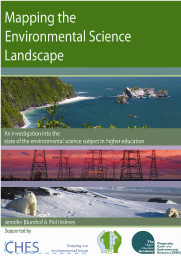Formal environmental science (ES) education in higher education institutions (HEIs) in the UK has been developing over forty years. The aim of this two phased project is to try and map this complex landscape over time by investigating recent provision from a number of perspectives and to make recommendations as to future directions and work. The complex landscape was illustrated in the Venn diagram in the recent revised Subject Benchmark Statement for Earth Sciences, Environmental Sciences and Environmental Studies (ES3) (www.qaa.ac.uk). Phase 1 of the report identifies issues with using JACS (Joint Academic Coding System) which, due to multiple changes in the way ES has been coded, makes detailed longitudinal studies very problematic. To try and address this problem undergraduate single honours programmes calling themselves Environmental Science were drawn from the plethora of JACS groups and used as an indicator to reveal 5 year trends. Additionally subject groups were joined together as the ‘ES contingent’ (JACS F850/851/890/900/990). Not only was the statistical data interrogated but surveys were also undertaken with ES in HEIs, providers (lecturers and programme leaders) and ES professionals. Use was also made of a recent report on the current agenda of sustainability in the higher education curriculum. Findings from the investigation can be grouped under the following aspects:
- Recruitment
- Changing structures
- Skills and Employment
- Future Provision
- Education for sustainability
The main findings of the project include:
- applications and enrolments have seen a very minor decrease against an overall increase in recruitment to HE
- there has been a reduction in the number of institutions offering ES as a single honours programme (currently 45),overall there has been a growing ‘core’ and shrinking ‘periphery’
- at present there are approximately 18000 students studying ES and closely aligned subjects which includes approximately 2200 students studying ES as a named single honours programme
- postgraduate provision has increased with approximately 4800 students studying in ES and aligned subjects in 2005
- academic structures have been undergoing change to cope with pressures such as student numbers, staff resources and new agendas
- providers felt concerned or uncertain about future provision though no dramatic change was thought to be on the horizon
- many ES providers saw the popularity of environmental issues in the media as a method of increasing recruitment
- many employers felt that whilst students had broad knowledge they were lacking in specialised skills relevant to the work place
- there is not a surplus of graduates and employers are still recruiting
- employers would like more input into the higher education curriculum.
Overall the ES landscape was found not to be in dramatic decline or rapid expansion and that there is scope and a platform for reigniting interest. As one respondent stated there is “the chance to make a real difference”. Phase 2 will involve a panel of ES higher education providers interrogating the findings in order to examine trends and issues, make recommendations for the direction of the discipline and further study. This work is being led by the Committee for the Heads of Environmental Sciences (CHES) and supported by the Higher Education Academy Subject Centre Geography, Earth and Environmental Sciences (GEES) and the Institution of Environmental Sciences (IES).


